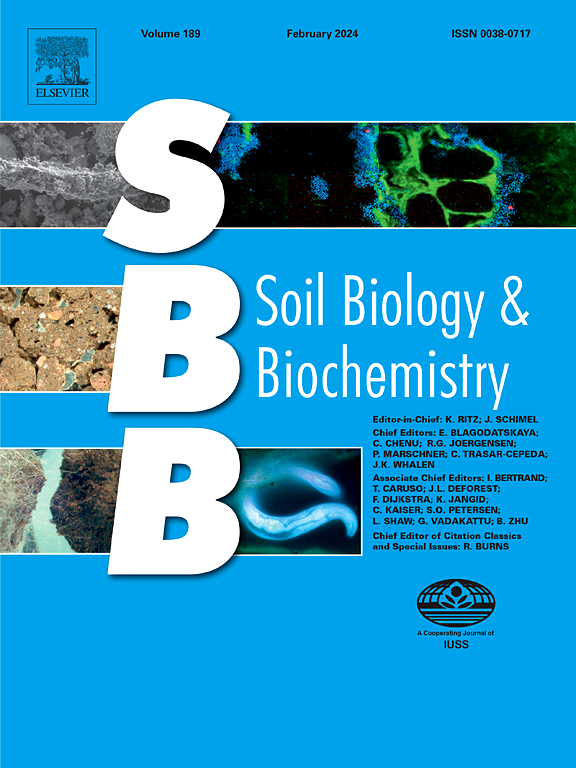Differences in straw derived hydrophilic and hydrophobic carbon incorporation into soil microbial necromass
IF 10.3
1区 农林科学
Q1 SOIL SCIENCE
引用次数: 0
Abstract
Microorganisms are important modulators for transformation and allocation of straw-derived carbon into soil organic carbon (SOC). However, little is known about how straw-derived dissolved organic matter (DOM) is converted into microbial necromass carbon in soil. To address this, hydrophilic (Hi-DOM) and hydrophobic (Ho-DOM) carbon fractions were extracted from cotton straw and added to soil with a 10-year history of straw incorporation for a 45-day mineralization incubation. CO2 emissions and 13C enrichment after addition of 13C-labeled Hi-and Ho-DOM into soil were analyzed, and the differences between the utilization of Hi-and Ho-DOM by microorganisms, as well as their incorporation into amino sugars were also determined. The results revealed that during the initial incubation phase (0.25–5 days), the mineralization rate of Hi-DOM was 1.1–2.7 times faster than that of Ho-DOM. Furthermore, cumulative CO2 production gradually increased during the incubation, and by the end of the experiment, Hi-DOM yielded 1.4 times more CO2 than Ho-DOM. Moreover, both Hi-DOM and Ho-DOM exhibited a positive priming effect. Similarly, the 13C content derived from Hi-DOM (0.48 mg g−1) was noticeably higher than that from Ho-DOM (0.41 mg g−1) in SOC. Residual 13C from Hi-DOM and Ho-DOM accounted for 20.1 % and 35.6 % of the total added carbon, respectively, indicating the dependence of microbial C uptake on substrate quality. Higher 13C-GlcN and 13C-MurN levels were witnessed in Ho-DOM and Hi-DOM-treated soils, respectively. Furthermore, Hi-DOM-treated soil exhibited higher bacterial necromass 13C and total microbial necromass 13C than Ho-DOM-treated soil, suggesting a fungal preference for complex compounds while bacteria preferred the utilization of simpler substrates for amino sugar formation. Furthermore, Hi-DOM exhibited prolonged and faster soil activity, as evidenced by significantly increased Hi-DOM-sourced 13C enrichment percentages in the amino sugar pool by the end of incubation. In conclusion, the distinct properties of straw-derived DOM can alter the intensity and magnitude of its conversion into microbial necromass carbon. Combined with the differential contributions of newly formed microbial residues to the SOC pool, this study enhances predictions of how straw carbon incorporation influences microbial carbon storage capacity and SOC sequestration potential.
土壤微生物坏死团中秸秆产生的亲疏水碳掺入的差异
微生物是秸秆碳向土壤有机碳转化和分配的重要调节因子。然而,秸秆衍生的溶解有机质(DOM)是如何在土壤中转化为微生物坏死块碳的,人们知之甚少。为了解决这个问题,从棉花秸秆中提取亲水性(Hi-DOM)和疏水性(Ho-DOM)碳组分,并将其添加到具有10年秸秆掺入历史的土壤中,进行45天的矿化培养。分析了向土壤中添加13C标记的hi和Ho-DOM后的CO2排放和13C富集情况,并测定了微生物对hi和Ho-DOM的利用以及它们在氨基糖中的掺入量的差异。结果表明,在孵育初期(0.25 ~ 5 d), Hi-DOM的矿化速度比Ho-DOM快1.1 ~ 2.7倍。此外,在孵育过程中,累积CO2产量逐渐增加,实验结束时,Hi-DOM的CO2产量是Ho-DOM的1.4倍。Hi-DOM和Ho-DOM均表现出正启动效应。同样,SOC中Hi-DOM的13C含量(0.48 mg g−1)明显高于Ho-DOM (0.41 mg g−1)。Hi-DOM和Ho-DOM的残余13C分别占总碳添加量的20.1%和35.6%,表明微生物对C的吸收依赖于底物质量。高dom和高dom处理的土壤中13C-GlcN和13C-MurN含量分别较高。此外,与ho - dom处理的土壤相比,hi - dom处理的土壤显示出更高的细菌坏死质量13C和总微生物坏死质量13C,这表明真菌偏爱复杂的化合物,而细菌更喜欢利用更简单的底物来形成氨基糖。此外,在培养结束时,氨基糖池中Hi-DOM来源的13C富集百分比显著增加,证明了Hi-DOM表现出持久和更快的土壤活性。综上所述,秸秆DOM的不同性质可以改变其转化为微生物坏死团碳的强度和幅度。结合新形成的微生物残留物对有机碳库的不同贡献,本研究增强了对秸秆碳吸收如何影响微生物碳储量和有机碳固存潜力的预测。
本文章由计算机程序翻译,如有差异,请以英文原文为准。
求助全文
约1分钟内获得全文
求助全文
来源期刊

Soil Biology & Biochemistry
农林科学-土壤科学
CiteScore
16.90
自引率
9.30%
发文量
312
审稿时长
49 days
期刊介绍:
Soil Biology & Biochemistry publishes original research articles of international significance focusing on biological processes in soil and their applications to soil and environmental quality. Major topics include the ecology and biochemical processes of soil organisms, their effects on the environment, and interactions with plants. The journal also welcomes state-of-the-art reviews and discussions on contemporary research in soil biology and biochemistry.
 求助内容:
求助内容: 应助结果提醒方式:
应助结果提醒方式:


